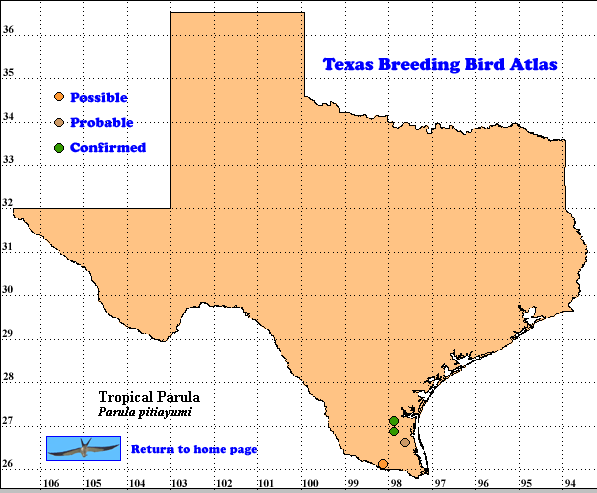Tropical Parula was formerly considered conspecific with the Northern Parula (Parula americana), then separated under the name Olive-backed Warbler before receiving it’s present English name. It is an amalgam of 14 recognized subspecies ranging from Texas to Argentina. These races show differences in size, plumage, vocalization, breeding habitat and probably breeding season. The subspecies in Texas and eastern Mexico is P. p. nigrilora. A larger subspecies is found in the Sierra Madre Occidental of Mexico from Sonora to Oaxaca (Howell and Webb 1995, Pyle 1997, Regelski and Moldenhauer 1997).
DISTRIBUTION. During the 1987-1992 field work seasons of the TBBA project, observers found a confirmed breeding site in latilong 27097, quad B7 and 2 confirmed records in 26097-G7. There were also single probable and possible records in quad F6 of this latilong. A final possible site was recorded in latilong 26098, quad A2. Subsequently Tropical Parulas have been reported in summer north along the coast to Calhoun and Victoria counties. Nesting and territorial males have been reported on the southern Edwards Plateau, on the Devils River in Val Verde County and even in the Davis Mountains (Lockwood and Freeman 2004).
SEASONAL OCCURRENCE. Tropical Parulas are summer residents in south Texas and north along the coast to Kenedy County, in western Texas and in northern Tamaulipas. Migrants begin arriving in mid-March and leave by September. The breeding season extends from mid-April to mid-July based on egg dates from May 2-23 and young in the nest as late as July 5. The exact status of Tropical Parulas present in winter in Texas needs further study (Oberholser 1974, Howell and Webb 1995, Regelski and Moldenhauer 1997, Lockwood and Freeman 2004)
BREEDING HABITAT. Tropical Parulas breed in Texas in areas where epiphytes are found on deciduous trees such as live oak, cedar elm, Mexican ash and sugar hackberry. The nest is built by the female, often toward the end of a branch. The nest is hollowed out of the hanging epiphyte (usually a ball or Spanish moss in Texas) and lined with hair or plant fiber. In the cup, the female usually lays 3 (range 2-5) white eggs, speckled with various shades of brown over spots, and often forming a wreath around the large end of the egg. Almost no information is available on the rest of the breeding cycle (Regelski and Moldenhauer 1997)/
STATUS. Oberholser (1974) showed records for Tropical Parula only north to southern Kenedy County and west to Starr County with breeding only in Cameron and Hidalgo counties. Since 1974 distribution has expanded both north and west, and the species is now rare to uncommon on the southern coast and in the lower Rio Grande River valley and rare and local in summer elsewhere in the range listed above (Lockwood and Freeman 2004). In 2005 a territorial male was found in riparian habitat on the Nueces river in San Patricio County (Skoruppa and Blacklock 2007)/ This range expansion is encouraging for the future of Tropical Parulas in Texas. Text by Robert C. Tweit (2007)

 Literature cited:
Literature cited: